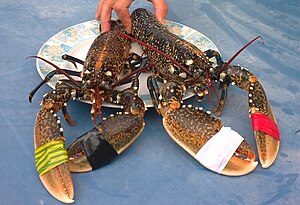Cookbook:Lobster
| Lobster | |
|---|---|
 | |
| Category | Shellfish |
Cookbook | Recipes | Ingredients | Equipment | Techniques | Cookbook Disambiguation Pages | Ingredients | Seafood
Lobsters are crustaceans related to shrimp, crab, crayfish, and krill.
In coastal areas close to where lobsters are caught, this seafood is not prohibitively expensive, and lobsters are often considered a summertime picnic treat. However, shipping costs for the living animals are high, so elsewhere lobsters are considered an elegant, formal, showy, and extravagant seafood. Shrimp may be considered a less expensive and difficult substitute.
When messy eating is acceptable, lobster is served in the shell. Tools, such as pliers and hammers, should be provided to open the brittle shells. For those who desire the distinctive taste of lobster without the mess, there are recipes for prepared lobster meat, such as Lobster Newberg.
Purchase an actively moving live lobster. Smaller lobsters are a better deal, but extravagant dining may demand the largest specimen available. Note: make sure to remove the rubber bands before placing the lobster in water. Otherwise, the rubber bands may leave a taste on the lobster.
How you proceed next depends on your stance regarding the ability of lobsters to feel pain. Many people believe it is more humane to kill the lobster before cooking it, while other people drop the live lobster directly into boiling water. If you fall into the former camp, these are the two usual methods:
- Put the lobster in the freezer one to two hours before cooking. This will not kill the lobster, but will render it unconscious. It will die in the boiling water before it can fully reawaken.
- Freeze the lobster for about fifteen minutes to slow down the lobster's nervous system. Place the lobster upside down on a cutting surface, then take a sharp knife and position it between the hindmost legs. Thrust firmly downward and slice through the body straight up to the head. Boil immediately.[1]
Otherwise, you can place the lobster head first in a large pot of rapidly boiling (optionally salted) water, and allow the water to return to a boil. Boil for ten minutes for the first pound, and around 3 minutes for each additional pound. The lobster can be considered done when its antennae can be easily pulled from the body.
Most of the meat is in the tail and large claws. Additional meat can be found in the smaller legs and near where the legs join the body. The soft white deposits are coagulated protein.
Lobster is often dipped into melted butter or cocktail sauce. Lobster also goes well with lemon juice and with salt.
- Side Notes:
- The hissing sound while cooking the lobster is not the lobster screaming, but merely steam escaping the shell.
- Some debate arises as to whether lobsters can feel any pain. A CBS news story [2] reported on a 2005 Norwegian study which concluded lobster brains are too small to experience pain. On the other hand, Business Insider [3] reported on a 2014 study from Queen's University in Belfast that indicates crustaceans such as lobsers and crabs are capable of experiencing pain.